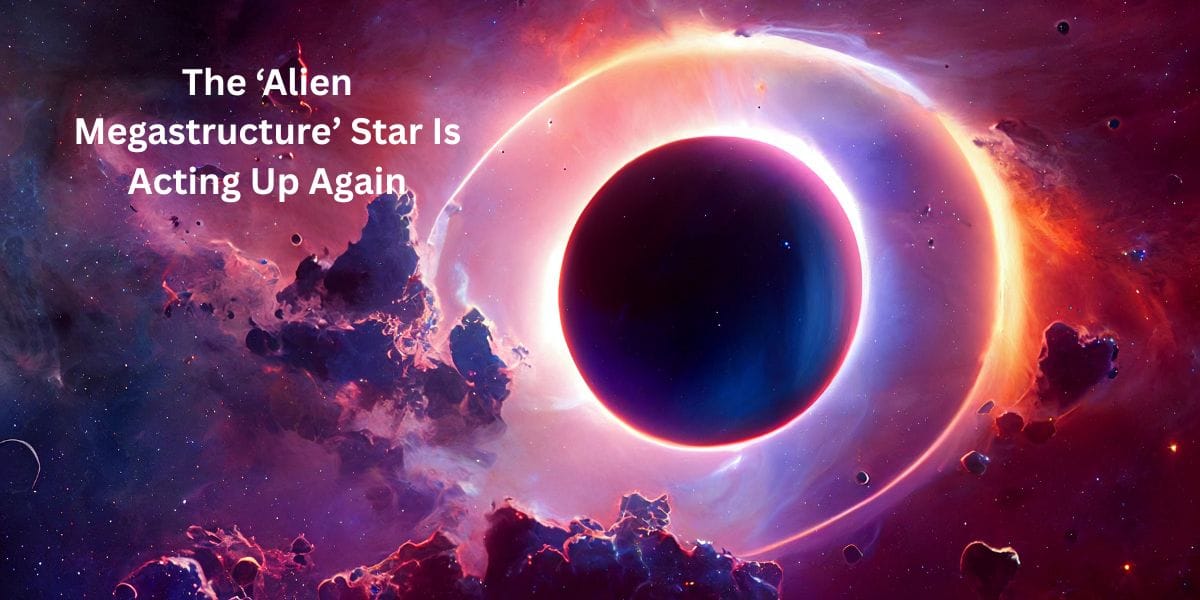Have you ever looked up at the night sky and wondered if we’re alone in the universe? Well, scientists are asking the same question—thanks to a strange star behaving in ways no one can fully explain.
This star, called KIC 8462852 (also nicknamed “Tabby’s Star”), has been puzzling astronomers for years. Sometimes, its light dims dramatically—as if something huge is passing in front of it. But what could be blocking a star’s light like that? A planet? A cloud of dust? Or… something else?
Now, the star is acting up again, and scientists are watching closely. Could this finally give us answers—or make the mystery even deeper?
What Is Tabby’s Star?
Tabby’s Star is a star 1,470 light-years away from Earth. It looks like a normal star at first, but something weird happens—its brightness drops suddenly, sometimes by up to 22%. That’s a huge dip!
For comparison:
- When a planet like Jupiter passes in front of a star, the star’s light dims by only 1%.
- Tabby’s Star dims much more, and the dips are irregular—no clear pattern.
This strange behavior made scientists wonder: What could be causing this?
Why Is Tabby’s Star Called the ‘Alien Megastructure’ Star?
In 2015, astronomer Tabetha Boyajian (who the star is named after) and her team found something shocking. The star’s light dips were too extreme to be caused by planets or comets.
One wild theory suggested that an alien megastructure, like a Dyson Sphere, might be blocking the light. A Dyson Sphere is a hypothetical giant structure built by an advanced civilization to collect a star’s energy.
But before we jump to aliens, scientists looked for natural explanations first.
What Could Be Causing the Strange Light Dips?
Scientists have many ideas, but none fully explain the star’s behavior. Here are the top theories:
A Swarm of Comets or Dust Clouds
- Maybe a huge group of comets or space dust is passing in front of the star.
- Problem: The dips are too big for normal comet swarms.
A Broken-Up Planet or Asteroid Field
- A planet might have exploded, leaving debris that blocks the star’s light.
- But: The dips don’t match a planet’s usual debris patterns.
An Alien Megastructure (The Most Exciting Idea!)
- Could a super-advanced civilization be building something around the star?
- Scientists say: Unlikely, but not impossible. We need more proof.
Why Is the Star Acting Up Again in 2025?
In June 2025, astronomers noticed new strange dips in Tabby’s Star’s light. This isn’t the first time—similar dips happened in 2011, 2013, and 2017.
But this time, scientists have better telescopes and tools to study it. Maybe we’ll finally get answers!
Could This Really Be Aliens?
The idea of aliens is exciting, but scientists always look for natural explanations first. Right now, the best guess is space dust or unusual cosmic events.
However, until we know for sure, the mystery remains. And that’s what makes space so fascinating!
The Mystery Continues
Tabby’s Star is one of the biggest space mysteries of our time. Every time it acts strangely, scientists get closer to solving the puzzle.
Is it aliens? Probably not. But the universe is full of surprises—who knows what we’ll discover next?
📌 Frequently Asked Questions
Where is Tabby’s Star located?
Tabby’s Star is 1,470 light-years away in the constellation Cygnus.
How did Tabby’s Star get its name?
It’s named after astronomer Tabetha Boyajian, who first studied its strange behavior.
What is a Dyson Sphere?
A Dyson Sphere is a theoretical giant structure built around a star to collect its energy.
Could the dimming be caused by a black hole?
No, a black hole would bend light differently and not cause these exact dips.
How often does Tabby’s Star dim?
The dimming is irregular—sometimes years apart, sometimes months.
Have we found any signals from Tabby’s Star?
No alien signals have been detected, but scientists keep checking.
What telescope discovered Tabby’s Star’s strange behavior?
NASA’s Kepler Space Telescope first spotted the unusual dimming.
Is Tabby’s Star the only star behaving this way?
A few other stars show similar dips, but none as extreme as Tabby’s Star.
Could it be a glitch in the data?
Scientists have checked—the dimming is real, not a telescope error.
Will we ever solve this mystery?
With better technology, we might! Each new observation brings us closer to the answer.
